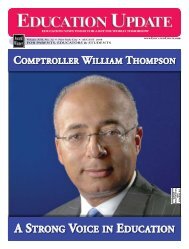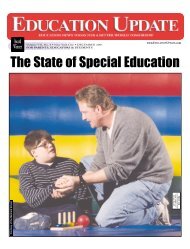Education Update - July 2002
Education Update - July 2002
Education Update - July 2002
You also want an ePaper? Increase the reach of your titles
YUMPU automatically turns print PDFs into web optimized ePapers that Google loves.
JULY <strong>2002</strong> ■ EDUCATION UPDATE ■ SPOTLIGHT ON SCHOOLSNew Series: Parents are seeking alternatives to public schools. <strong>Education</strong> <strong>Update</strong> reports on two in this issue.New Middle School at MarymountBy SYBIL MAIMINStudents in the fourth through seventh gradesat the Marymount School are moving intobright new quarters in the fall. The independentCatholic girls’ school (nursery through 12),now housed in three beautiful adjacent townhouseson Fifth Avenue, has acquired and isrenovating a Beaux Arts building on nearbyEast 82nd Street which will serve MiddleSchool students exclusively.As explained by headmistress SisterKathleen Fagan, this is an effort to give youngstersin a sometimes difficult stage of life “aspecial place where they can shine.” The schoolwill be a blend of the old and the new, a selfcontainedunit with its own program, faculty,dining hall and commons, library, science lab,computer center, and technical facilitator. Aspecial advising system is being established.The students will interface with girls from theupper and lower schools in shared use of thechapel, gym, and assembly as well as in schoolservice programs. The addition of a building,more a reflection of the need for “breathingroom” following several years of increasedenrollment than of plans for further growth,will be followed by incremental renovations ofthe original mansions including expansion ofdining, library, technology, music, drama, andart facilities.Though the stately buildings recall anotherera, the activities within are cutting edge. DonBuckley, director of technology at Marymount,oversees integration and faculty development.The key, he says, “is to get teachers to discoverwhat technology works for them and getthem to run with it.” The school has grantmoney to reward teachers who come up withinteresting proposals about classroom applications.Marymount conducts summer technologyworkshops open to professionals from otherinstitutions. Utilizing online learning, it was thefirst school in Manhattan to enroll students in aColumbia University course in Java, a computerlanguage. Technology is introduced inkindergarten and, as they advance in grade,pupils do everything from creating fictitiousonline businesses to making videos of frog dissections.Marymount is part of a religious order foundedin Beziers, France in 1849. It is devoted toeducation and today has schools in 14 countries.They are not parochial (church or parishaffiliated). Marymount, New York is part of anetwork that includes schools in London, Paris,Rome, and Los Angeles. Representatives ofnetwork institutions meet annually and setgoals and objectives. Each has an implementationcommittee. Instilling values is central tothe school mission, and each year a particularvalue, such as the current “Unity ThroughDiversity,” is chosen by the network for specialfocus. Recognizing changes in the Church andsociety, the network is presently developingplans to pass the schools on to lay leaders. InNew York, only three sisters remain on a facultyof 75. As fewer people choose a religious lifeand the community work that needs to be donegrows, schools that lose clergy must transfertheir governance or close down. MarymountNew York has been administered by a layBoard of Trustees since 1969, but has continuedto be headed by clergy. Headmistress SisterKathleen welcomes the coming changes notingthat, previously clergy were considered an eliteclass, but now we are all equal in our possibilitiesof goodness.#Private or Public <strong>Education</strong>?By CHRISTINA PERPIGNANOAND ZAHER KARPRecently on WNYC radio, Brian Lehrer featureda panel of authors and consultants discussingthe choices that a parent must gothrough when caught between the accessibilityof the public school system and the exclusivityof the private schools of New York. The panelconsisted of Clara Hemphill, author of NewYork City’s Best Public High Schools. AParents’ Guide, Catherine Hausman, author ofThe Manhattan Family Guide to PrivateSchools and Robin Aronow, psychotherapistand educational consultant.The panel discussed the many different issuesin the debate of private vs. public school.Topics such as financial and social considerationsas well as cultural issues were included.Private schools are unattainable to many familiesbecause of their high tuition. However, asthe speakers pointed out, scholarships andfinancial aid are available. One of the callerswas concerned with the lack of diversity withinthe private school system. This was confirmedby the panel. However, they noted thatmany private schools are making an effort tointroduce a multicultural element into the studentbody.As the panel pointed out, the disadvantage tofamilies that must rely upon the public school systemis that there are few choices within the district,while a private school student has no such constraints.The advantages of private schools is thatthey have the facilities to concentrate on the studentas an individual and “make sure the child iswell rounded,” according to Aronow.Ramaz Lower SchoolBy POLA ROSEN, Ed.D.Established 65 years ago, the Ramaz LowerSchool is a modern, orthodox Jewish day schoolthat was originally built for the community andhas continued with that vision. Head of the schoolRabbi Alan Berkowitzexplained that “Ramaz representsa standard of excellencein the world of Jewisheducation. Starting in nursery,we try to provide a qualityprogram that will lead toan outstanding education.”The student-teacher ratio islow: about 15 students to aclass with a head teacher andassistant teachers.The curriculum is half–religious and half–secular.Our children are expected tofollow the laws and principlesof Judaism. The firstgraders participate in aCommunity service has always been anaspect exclusive to private schools, but recentlymore and more, public schools are requiringit as well. In public schools, parental control ofthe curriculum and administration is at a minimum,but at a private school, parents havegreater control of the system. The speakersindicated that some public schools lack leadershipespecially because their principals andadministrators are paid poorly.The panelists agreed that private schoolsSCHOOL7Hebrew language immersionprogram. In the secondgrade, the entire religiouscomponent is taught inHebrew, which is considered the heritage language.French and Spanish are introduced in themiddle school. Project Community takes placein the middle school. Once a week students volunteerunder the supervision of their teachers.“Our school has a strong sense of commitmentbecause many of the parents are Ramazgraduates,” said Rabbi Berkowitz. The missionof Ramaz is for students to be outstanding citizensof the world and to excel. In recruiting students,parents must share the mission. Studentsare recruited by an interview process with parents.In the lower school students come fromall boroughs. In the upper school, students alsocome from Connecticut and New Jersey. Mostgraduates spend a year in Israel studying andexploring roots. Then they enroll in many ofStudents at Ramaz Lower Schoolperforming with Hebrew letters.the best universities in the country.On teacher recruitment, Berkowitz looks foreducators who have long-term experience and acommitment to their mission. Most of theteachers have Master’s degrees in education.Judaic studies teacher must be fluent inHebrew. An unusual feature of the school is theday-care center for faculty children.The atmosphere of the school is nurturingand caring. No wonder then, as Berkowitznoted, “Parents have an enthusiasm about thisplace; the school has charisma.”#seem to be the best environment for a youngchild who needs individual supervision, whereaspublic schools require the child to have acertain degree of independence and self sufficiency.Parochial schools, on the other hand,seem to be a good balance between the twobecause the tuition is less than the majority ofthe private schools.#Christina Perpignano & Zaher Karp are studentsin private schools in NYC and interns at<strong>Education</strong> <strong>Update</strong>.
















